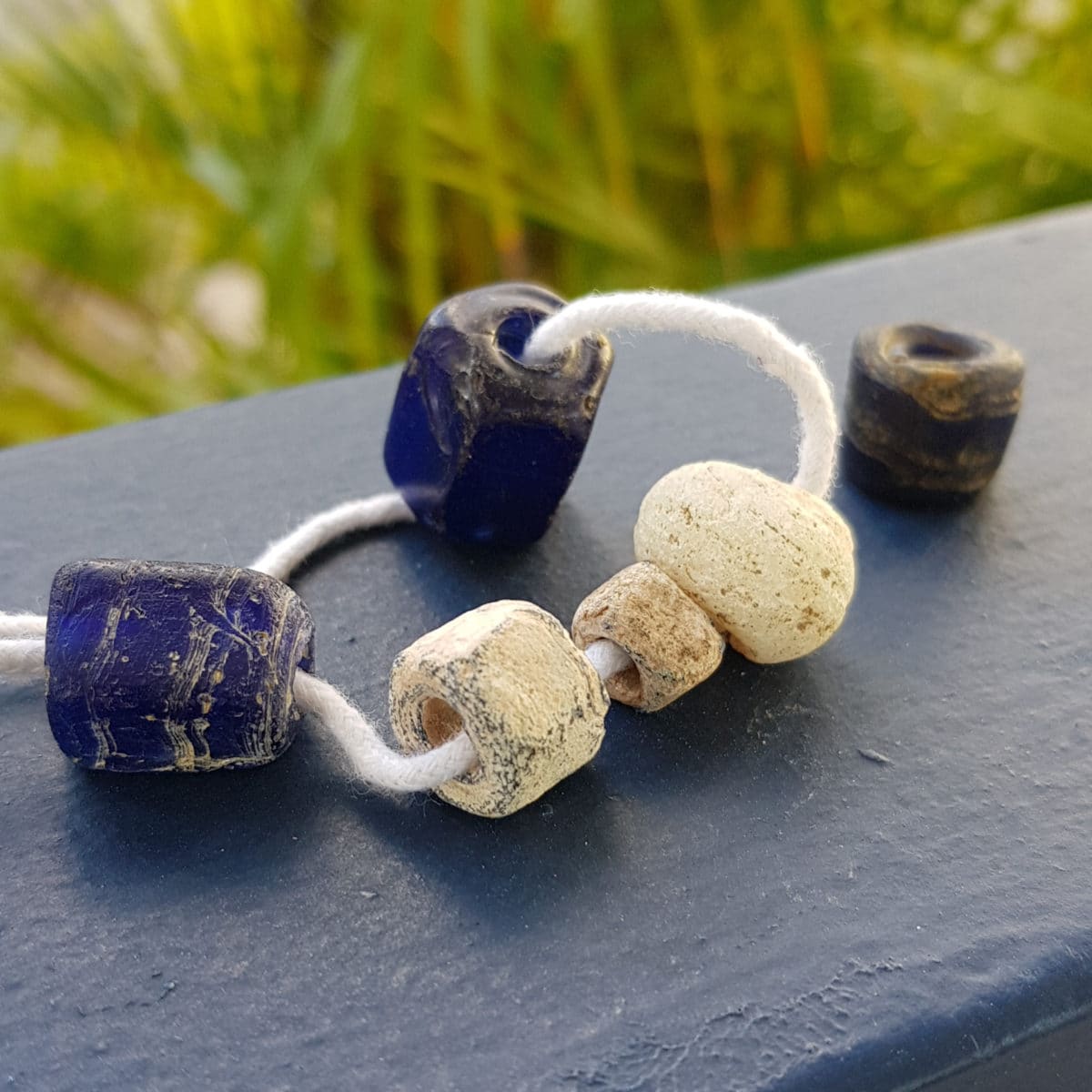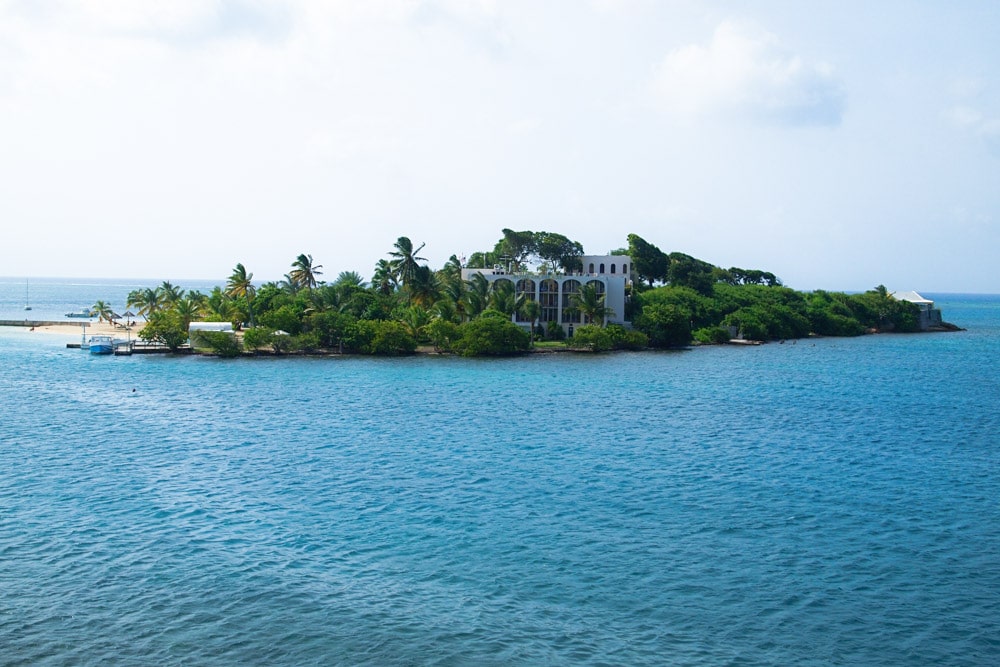The Surprising Slave History and Mystical Legend of Statia Blue Beads
Of all the many varied, unique, and amazing types and styles of jewelry found all throughout the Caribbean, none are more uncommon than these beautiful beads from St. Eustatius (Statia). They’re called blue beads, a name so banal you might be tempted to think nothing of them. Underestimating Statia blue beads would be a mistake, though. Especially if you appreciate Caribbean history, freedom, and serendipity.
Statia Slave History
To fully understand the blue beads, you must first understand a bit about the history of St. Eustatius, a tiny (eight square miles!!) island with a decidedly Dutch colonial past. Part and parcel to that past, as most everywhere else in the Caribbean of course, is slavery.
The first slaves were brought to Statia from Africa in the mid-1600’s. Plantations focused on tobacco, cotton, and sugar cultivation at the time. A great many more slaves were brought to Statia than could ever work the island’s small collection of plantations, however.
The reason: St. Eustatius was a free port.

This status, adopted in 1756, along with the island’s large natural harbor and neutral political stance, enabled Statia to grow rapidly into a nexus for all types of trade (legal and illicit) among all the typically warring European colonial powers. French, Spanish, English, Danish, Dutch – they all did a brisk business here.
In this way, Statia was the de facto center for virtually all slave trade in the Northern Caribbean. This is where the blue beads come in…
Statia Blue Beads History
The [blue] beads were made from spun glass, sometimes factory cut or “handmade”, usually shaped like 5-sided prisms (which we call locally “5 corner Beads”)…
These are the words of Ms. Misha Spanner, as bona fide an expert on Statia blue beads as exists anywhere. Ms. Spanner, who works with the St. Eustatius Historical Foundation, also happens to possess a rather extensive collection of Statia blue beads.

I corresponded with her via email several times recently to get the full story on these unique treasures.
They [blue beads] were made in factories in the Netherlands… Venice was also a popular area where beads were produced… I grew up usually hearing the Beads referred to as, or called on the island “Trade Beads”, “Slave Beads”, and also some people called them “African Beads” based on their connection to slavery…
This connection to slavery has two aspects, one of which is truly fascinating to me.
Paying Slaves
I had always thought that slaves were never rewarded in any way for their work. After all, they were considered property. Routine subjection to unspeakably inhumane atrocities was the norm.
Statia blue beads, though, add a little more context to that dark historical reality.
…Slave Masters paid or rewarded them [slaves] with Blue Beads… The slaves traded/bartered the “Blue Beads” or “Beads” amongst themselves similar as Money/Currency), where they could purchase, trade goods or negotiate services amongst themselves. The size of the beads also varied in value or worth… The more beads a slave had, showed their rank, even though the slave was still poor and not free. For example, the large round Beads that we call locally “Marble Beads”, slaves that earned these larger beads, had a higher position than the other slaves. Even for a slave to marry, he had to work for enough beads to fit around her waist.
Considering there were slave owners living in, and/or doing business in Statia from all over the colonized Caribbean, the practice of rewarding slaves with blue beads naturally spread throughout the region.
Why, then, are the blue beads so inherently linked to St. Eustatius?
Paying For Slaves
The currency of blue beads wasn’t confined to slave communities based in the Caribbean. European slave traders used the beads as a principal means of purchasing slaves in Africa as well. Because of Statia’s status as the primary hub of slave trade in the Caribbean, vast quantities of blue beads were shipped there during the 17th and 18th centuries. They were stored in warehouses sprinkled throughout the island creating a ready supply benefiting area slave owners, as well as slave traders sailing to Africa.
The dawning of Emancipation would change all this, of course.
The Scattering of the Statia Blue Beads
Slavery was abolished in the Dutch Antilles on July 1, 1863, a milestone event that rendered the blue beads useless overnight. Large stocks of the baubles stored all over Statia were discarded or forgotten as the old warehouses were abandoned and slowly decayed.
Slaves in St. Eustatius took a more dramatic approach to ridding themselves of their blue beads…
During the official abolishment of slavery, symbolically, what the slaves did as a symbol of their freedom, some slaves took off their necklaces and threw them over the cliffs or into the sea.

The beads, like the chains and shackles that previously denied their freedom, now cast to winds and waves.
Statia Blue Beads Today
The large stocks of blue beads stored in St. Eustatius during the colonial period ensures that you’re more liable to find these historic artifacts here than anywhere else in the Caribbean. When you go looking, though, you should know that Statia blue beads aren’t always blue.
In general the majority of Beads found on the island are usually colored different shades of blue ranging in (dark blue, medium blue, light blue). What is also unique about the “Blue Beads” found on Statia is, they can be found in different shades of colors such as pearlish [sic] white, dark green, opaline, orange, red, purple, black, and also a combination with different mixture of colors.
Another thing to know about Statia blue beads is that you don’t actually find them… They find you!
According to local legend, if you’re meant to have blue beads, they’ll reveal themselves to you while you’re adventuring around St. Eustatius. Of course, you can always improve your odds by hiking or beach combing after a heavy rain.
Blue beads also routinely find scuba divers exploring Statia’s world class offshore reefs and other undersea environs.
No matter where Statia blue beads find you, though, just know that once they do, you’re destined to return to this magical island again and again.



